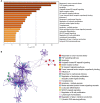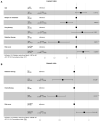Potential Molecular Mechanism of TNF Superfamily-Related Genes in Glioblastoma Multiforme Based on Transcriptome and Epigenome
- PMID: 33643183
- PMCID: PMC7905170
- DOI: 10.3389/fneur.2021.576382
Potential Molecular Mechanism of TNF Superfamily-Related Genes in Glioblastoma Multiforme Based on Transcriptome and Epigenome
Abstract
Objective: This study aimed to investigate the molecular mechanism of tumor necrosis factor (TNF) superfamily-related genes and potential therapeutic drugs for glioblastoma multiforme (GBM) patients based on transcriptome and epigenome. Methods: Gene expression data, corresponding clinical data, and methylation data of GBM samples and normal samples in the TCGA-GBM and GTEx datasets were downloaded. The TNF-related genes were obtained, respectively, from two groups in the TCGA dataset. Then, the TNF-related differentially expressed genes (DEGs) were investigated between two groups, followed by enrichment analysis. Moreover, TNF superfamily-related gene expression and upstream methylation regulation were investigated to explore candidate genes and the prognostic model. Finally, the protein expression level of candidate genes was performed, followed by drug prediction analysis. Results: A total of 41 DEGs including 4 ligands, 18 receptors, and 19 downstream signaling molecules were revealed between two groups. These DEGs were mainly enriched in pathways like TNF signaling and functions like response to TNF. A total of 5 methylation site-regulated prognosis-related genes including TNF Receptor Superfamily Member (TNFRSF) 12A, TNFRSF11B, and CD40 were explored. The prognosis model constructed by 5 genes showed a well-prediction effect on the current dataset and verification dataset. Finally, drug prediction analysis showed that zoledronic acid (ZA)-TNFRSF11B was the unique drug-gene relation in both two databases. Conclusion: Methylation-driven gene TNFRSF12A might participate in the development of GBM via response to the TNF biological process and TNF signaling pathway and significantly associated with prognosis. ZA that targets TNFRSF11B expression might be a potential effective drug for clinical treatment of GBM.
Keywords: DNA methylation; differentially expressed genes; glioblastoma multiforme; survival analysis; tumor necrosis factor superfamily genes.
Copyright © 2021 Xie, Yuan, Li, Li and Lu.
Conflict of interest statement
The authors declare that the research was conducted in the absence of any commercial or financial relationships that could be construed as a potential conflict of interest.
Figures






Similar articles
-
Bioinformatics analyses of significant genes, related pathways and candidate prognostic biomarkers in glioblastoma.Mol Med Rep. 2018 Nov;18(5):4185-4196. doi: 10.3892/mmr.2018.9411. Epub 2018 Aug 21. Mol Med Rep. 2018. PMID: 30132538 Free PMC article.
-
A 63 signature genes prediction system is effective for glioblastoma prognosis.Int J Mol Med. 2018 Apr;41(4):2070-2078. doi: 10.3892/ijmm.2018.3422. Epub 2018 Jan 25. Int J Mol Med. 2018. PMID: 29393370 Free PMC article.
-
Candidate Biomarkers and Molecular Mechanism Investigation for Glioblastoma Multiforme Utilizing WGCNA.Biomed Res Int. 2018 Sep 26;2018:4246703. doi: 10.1155/2018/4246703. eCollection 2018. Biomed Res Int. 2018. PMID: 30356407 Free PMC article.
-
DNA methylation profiling identifies potentially significant epigenetically-regulated genes in glioblastoma multiforme.Oncol Lett. 2019 Aug;18(2):1679-1688. doi: 10.3892/ol.2019.10512. Epub 2019 Jun 21. Oncol Lett. 2019. PMID: 31423235 Free PMC article.
-
The Roles of TNF Signaling Pathways in Metabolism of Bone Tumors.Front Pharmacol. 2022 Jun 29;13:907629. doi: 10.3389/fphar.2022.907629. eCollection 2022. Front Pharmacol. 2022. PMID: 35847045 Free PMC article.
Cited by
-
Association of rare variants in genes of immune regulation with pediatric autoimmune CNS diseases.J Neurol. 2022 Dec;269(12):6512-6529. doi: 10.1007/s00415-022-11325-2. Epub 2022 Aug 12. J Neurol. 2022. PMID: 35960392 Free PMC article.
-
Regulatory pattern of abnormal promoter CpG island methylation in the glioblastoma multiforme classification.Front Genet. 2022 Sep 19;13:989985. doi: 10.3389/fgene.2022.989985. eCollection 2022. Front Genet. 2022. PMID: 36199581 Free PMC article.
-
Phenethyl Isothiocyanate Suppresses the Proinflammatory Cytokines in Human Glioblastoma Cells through the PI3K/Akt/NF-κB Signaling Pathway In Vitro.Oxid Med Cell Longev. 2022 Mar 25;2022:2108289. doi: 10.1155/2022/2108289. eCollection 2022. Oxid Med Cell Longev. 2022. PMID: 35368876 Free PMC article.
-
Identification and Verification of Key Genes Associated with Temozolomide Resistance in Glioblastoma Based on Comprehensive Bioinformatics Analysis.Iran J Biotechnol. 2024 Oct 1;22(4):e3892. doi: 10.30498/ijb.2024.448826.3892. eCollection 2024 Oct. Iran J Biotechnol. 2024. PMID: 40225293 Free PMC article.
-
Barriers to overcoming immunotherapy resistance in glioblastoma.Front Med (Lausanne). 2023 May 18;10:1175507. doi: 10.3389/fmed.2023.1175507. eCollection 2023. Front Med (Lausanne). 2023. PMID: 37275361 Free PMC article. Review.
References
LinkOut - more resources
Full Text Sources
Other Literature Sources
Research Materials

